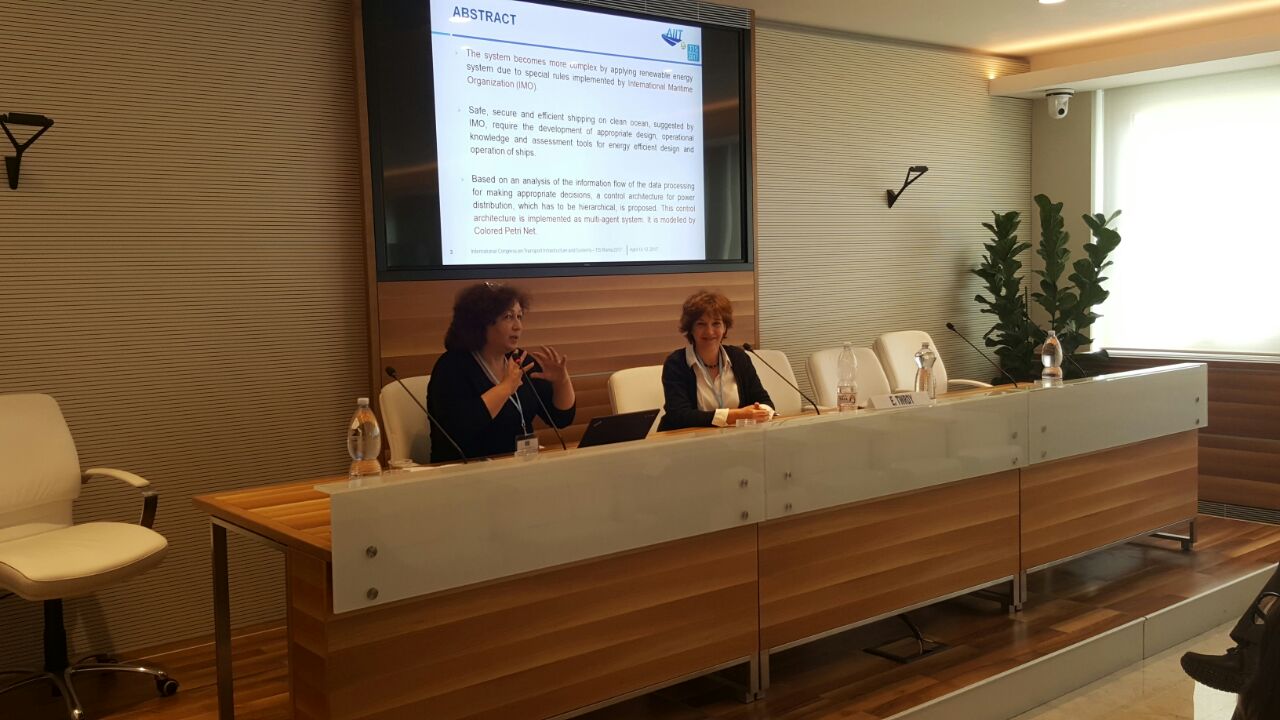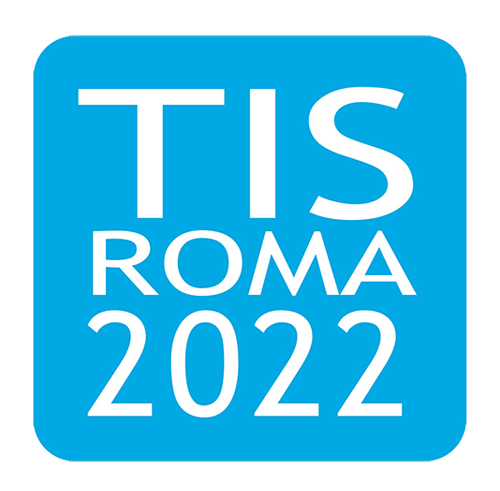TIS 2017
Session 15 – Maritime transport and hubs

The future of maritime transport was the issue of this session of the TIS Congress which offered a complete overview of the future of maritime transport systems in the Mediterranean area. The problem of re-inventing the role of ports and hubs was deeply analyzed, presenting projects, solutions and experiences from different countries.
Maja Krcum and Anita Gudelj, Modelling of a Multi-Agent Architecture for Power Management System on a Ship – The object of this work was to present the design of an information system for the management of power system on a ship using software agents. The Power Management System is a critical part of the control equipment in the ship. It is usually distributed on various control stations that can operate together and share information between each other or independently in case of special emergency situations in which ship have to operate. The system becomes more complex by applying renewable energy system due to special rules implemented by International Maritime Organization (IMO). Based on an analysis of the information flow of the data processing for making appropriate decisions, a control architecture for power distribution, which has to be hierarchical, was proposed. This control architecture is implemented as multi-agent system. It is modelled by Colored Petri Net.
Zvonimir Lušić, Danijel Pušić and Dario Medic, Analysis of the maritime traffic in the central part of the Adriatic – This paper analyses maritime traffic in the central part of the Adriatic Sea as well as risk of collisions and groundings on the main sailing routes passing through this area. Here, in fact, two main traffic flows, northwest and southeast, are concentrated in two narrow paths, mainly safely separated due to traffic separation schemes in vicinity. But these main traffic flows overlap with routes of other vessels; fishing vessels, yachts, transversal traffic, etc. accordingly causing increased probability of accident. Calculation of probability of collisions and groundings was based on AIS traffic data and IWRAP software. Accordingly, some recommendations how to reduce risk of accidents were given.
Elen Twrdy and Milan Batista, Evaluating the competitiveness of transhipment ports in Mediterranean – Ports, as one of the most important links in the logistics chain, are forced to follow the fast progress of ship size and to adjust all technology and process to the new environment. This study present models to evaluate container transhipment ports in Mediterranean Sea. A detailed analysis on dynamics of containers by using portfolio analysis, market share analysis and shift-share analysis was presented. Then a simple Markov chain method was used in order to predict behaviour of this ports with respect to the identified trends in containers traffic. They concluded that there are not big differences in marker share between those ports. We calculated the HH index and saw that the concentrations is low (around 0.22) which means that all those ports are important players.
Stefano Gori and Marco Petrelli, A simulation model for managing port operations – The objective of this study is to create a simulation tool that involves the development and the management of the entire port infrastructure, using historical and real-time data, working with design and operating scenarios. Such infrastructures are characterized by several, different activities, often in overlap in space and time, involving critical issues about terminals capacity and reliability of ships scheduling. Such issues are growing for importance due to the combined effect of the increasing level of freight and the increasing difficulties in medium and long term investment projects. The simulation model was realized with a discrete-event approach using the software ARENA and a tool for a graphic user interface, implemented in the C# language. The model was implemented to simulate the activities in Civitavecchia, a multipurpose port, using real world data.
Paolo Fadda, Gianfranco Fancello, Claudia Pani and Patrizia Serra, The Optimed Project: A New Mediterranean Hub-Based Ro-Ro Network – The main objective of the study is to design a new optimised corridor between the two shores of the Mediterranean sea. The new corridor, founded on the hub-based concept, is composed by two hub ports: Porto Torres (Italy) and Beirut (Lebanon) serving the north-western area and the south-eastern area, respectively. A data collection process was performed in order to collect the information necessary to define the existing scenario and to characterise nodes (ports) and arcs (links) of the new network. Origin/Destination matrices was used to calibrate the network and alternative scenarios of future demand was built-up, in order to determine how the new network structure can be able to match changing demand over the years. Environmental balances was performed to assess the environmental efficiency of the new network with respect to the existing transport options.
Francesca D’Orsi – Terminal Operator / Francesca D’Orsi explained as a layer the figure of the terminal operator, which can best be defined as the main player in the complex of port operations within the port area, is still one of the most controversial figures in the context of maritime law, and more specifically as regards the juridical qualification to be given to the contracts stipulated with them for the execution of the aforementioned operations and the consequent regime of liability in terms of the fulfilment of their obligations.
CHAIRMAN: Elen Twrdy
The initial session program also included further presentations but for unpredictable reasons the speakers could not be present at the TIS congress.
Riccardo Gabriele Di Meglio, Silvia Ferrini, Giorgio Mainardi and Ivano Toni, Motorways of the Sea: an outlook of technological, operational and economic tools – The paper was about how new technologies can be successfully deployed within the MoS related logistic chains, analysing needs for monitoring the freight, improving safety of passengers flows, detecting hazardous events, in compliance with IMO directives and international regulations. Based on current practices, the paper will explore the use of RFID, e-seals, port monitoring platforms, in the light of market needs for reliable and interoperable ITS. The contribution will finally deal with the Port of Livorno case, analyzed as meaningful for other Mediterranean ports. This case study gives the chance to consider, in the real life of the first Ro-Ro port in Italy, the implementation of above mentioned technological, operational and economic tools.
Vittorio Marzano, Andrea Papola and Fulvio Simonelli, A methodology for evaluating the competitiveness of Ro-Ro services – This work proposes a methodology for the appraisal of the effectiveness of Ro-Ro services in competition with the all-road alternative. The methodology was applied for the analysis of the intermodal corridor Italy-Spain. The relevant ports are firstly analyzed in terms of their maritime accessibility, that is measuring the factors usually taken into account by shipping companies in choosing new routes/services. Then, a potential basin and an effective basin are defined for each port, respectively the first encompassing the set of o-d pairs whose maritime shortest path passes through that port, the second containing the o-d pairs with an actual convenience in choosing Ro-Ro with respect to the road mode. The basins are evaluated with reference both to an ideal maritime supply, that is with all ports connected among themselves, and to the current maritime supply between Italy and Spain. This allows the identification of new potential attractive routes, whose effective basin are in turn determined by applying the same proposed methodology.
Pietro Ugolini, Francesca Pirlone, Ilenia Spadaro and Selena Candia, Waterfront and sustainable mobility. The case study of Genoa – Nowadays many port areas are no more exploited for port’s trade. Several cities used these spaces designing modern waterfronts for leisure, culture and tourism activities. Waterfront revitalisation is also fundamental for urban mobility. Port cities can use these areas to develop new transport infrastructure promoting sustainable mobility. The case of one important port city in the Mediterranean, Genoa, was analysed. This analysis is necessary to define new forms of mobility and transport promoting sustainability inside port cities centres taking often advance of port abandoned areas.





